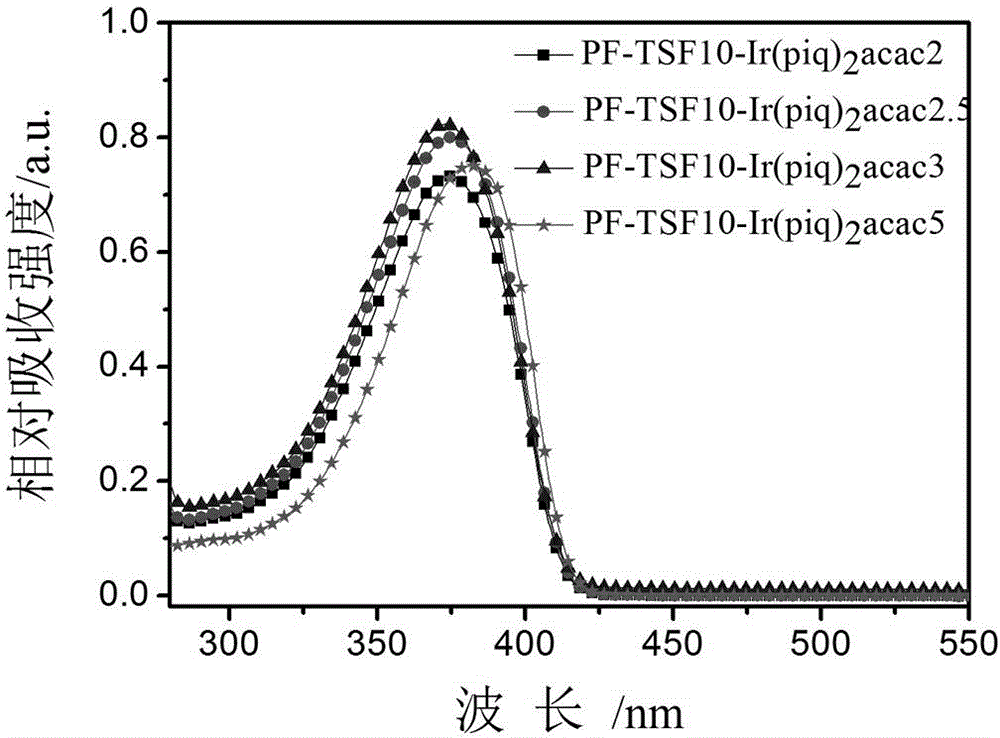Fluorescence-phosphorescence hybridized organic electroluminescent white light polymer and preparation method thereof
A polymer and white light technology, applied in chemical instruments and methods, circuits, luminescent materials, etc., can solve the problems of poor stability of blue phosphorescent dyes, affecting device chromaticity stability, and reducing device efficiency, etc., to achieve luminescent performance Excellent, avoids interface deterioration, and improves solubility
- Summary
- Abstract
- Description
- Claims
- Application Information
AI Technical Summary
Problems solved by technology
Method used
Image
Examples
Embodiment 1
[0035] Example 1: The synthesis center core spirobifluorene accounts for 10% of the total molar weight of the polymer, and the red light group Ir(piq) 2 Acac accounted for 0.02% of the total polymer molar fluorescent phosphorescence hybrid organic electroluminescent polymer.
[0036] 1) Synthesis of spiro[3.3]heptane-2,6-bis-(2’,2”,7’,7”-tetrabromospirofluorene) (M3)
[0037]
[0038]Add 3.26g (10mmol) of 2,7-dibromofluorene into a 250ml three-necked flask, vacuum three times with nitrogen, fully exhaust the air in the flask, add 50ml THF, stir and mix at room temperature for 30min, and mix 0.6g (25mmol) NaH was added to the flask five times, with an interval of 15 minutes between each dosing, vacuum pumping and nitrogen gas were carried out again, 1.70 g (4 mmol) of pentaerythritol bromide was dissolved in 20 ml of THF, and slowly dropped through a normal pressure separatory funnel within 30 min. into a three-necked flask to allow it to participate in the reaction. The i...
Embodiment 2
[0051] The synthetic central core spirobifluorene accounts for 10% of the total molar weight of the polymer, and the red light group Ir(piq) 2 Hyperbranched white photopolymer organic electroluminescent material with total molar weight of acac accounting for 0.025% of the polymer
[0052] Take 0.19g (0.35mmol) of 2,7-dibromo-9,9-dioctylfluorene (M1) and 0.35g of 9,9-dioctylfluorene-2,7-diboronic acid inanol ester (M2) (0.55mmol), central core spiro[3.3]heptane-2,6-bis-(2',2",7',7"-tetrabromospirofluorene) (M3) 0.07g (0.1mmol) was added to three ports In the flask, vacuumize and fill with nitrogen three times each, stir at room temperature, add 30ml of dehydrated toluene, 15ml of 2mol / L sodium carbonate solution, vacuumize and fill with nitrogen, take 1ml of Aliquant336 dissolved in 5ml of dehydrated toluene and add it to the three-necked flask in the reaction 0.1 g of tetrakis(triphenylphosphine)palladium was added, and the solution became golden yellow. Vacuumize and fill w...
Embodiment 3
[0055] The synthetic central core spirobifluorene accounts for 10% of the total molar weight of the polymer, and the red light group Ir(piq) 2 Hyperbranched white photopolymer organic electroluminescent material with the total molar weight of acac accounting for 0.03% of the polymer
[0056] Take 0.19g (0.35mmol) of 2,7-dibromo-9,9-dioctylfluorene (M1) and 0.35g of 9,9-dioctylfluorene-2,7-diboronic acid inanol ester (M2) (0.55mmol), central core spiro[3.3]heptane-2,6-bis-(2',2",7',7"-tetrabromospirofluorene) (M3) 0.07g (0.1mmol) was added to three ports In the flask, vacuumize and fill with nitrogen three times each, stir at room temperature, add 30ml of dehydrated toluene, 15ml of 2mol / L sodium carbonate solution, vacuumize and fill with nitrogen, take 1ml of Aliquant336 dissolved in 5ml of dehydrated toluene and add it to the three-necked flask in the reaction 0.1 g of tetrakis(triphenylphosphine)palladium was added, and the solution became golden yellow. Vacuumize and fil...
PUM
 Login to View More
Login to View More Abstract
Description
Claims
Application Information
 Login to View More
Login to View More - R&D
- Intellectual Property
- Life Sciences
- Materials
- Tech Scout
- Unparalleled Data Quality
- Higher Quality Content
- 60% Fewer Hallucinations
Browse by: Latest US Patents, China's latest patents, Technical Efficacy Thesaurus, Application Domain, Technology Topic, Popular Technical Reports.
© 2025 PatSnap. All rights reserved.Legal|Privacy policy|Modern Slavery Act Transparency Statement|Sitemap|About US| Contact US: help@patsnap.com



